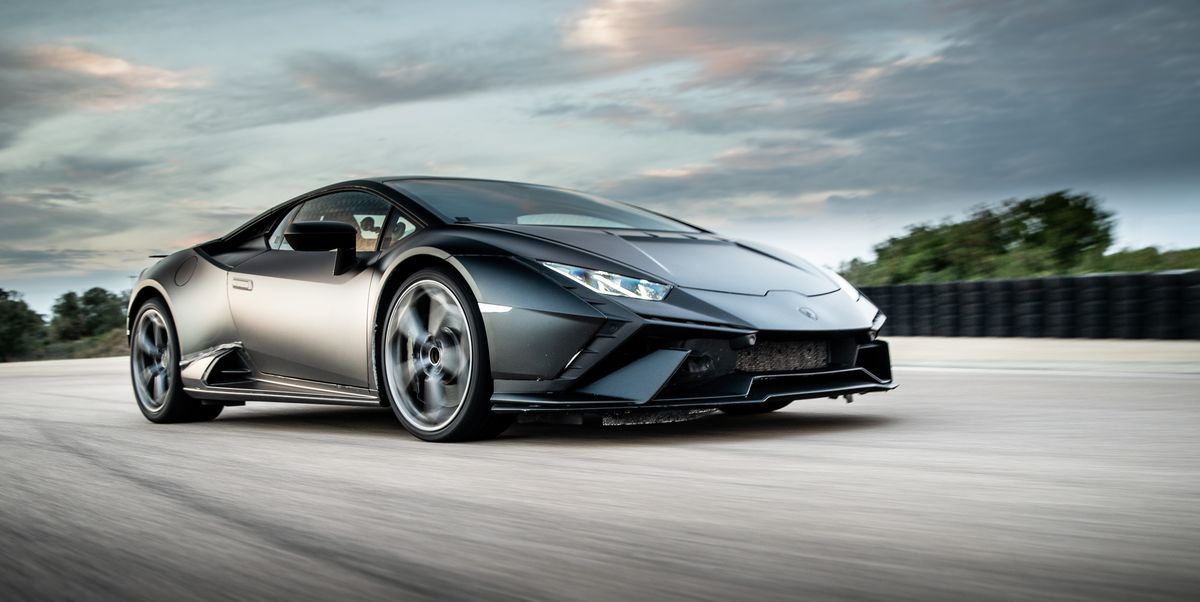Prototype Drive: 2022 Lamborghini Huracán Tecnica Has All the Best Bits

A greatest-hits compilation is usually a sign that a band is reaching the end of its career. The Lamborghini Huracán Tecnica, which we drove in prototype form, feels set to be such a valediction. It’s not the quickest or fastest Huracán, nor even the final variant of Lamborghini’s junior supercar. But it’s the one that seems to have all the best bits in it.
You can read a more detailed story about the changes to the Tecnica here. Our drive of a late-stage prototype took place at the vast Nardò test track in southern Italy late last year. The Tecnica can be regarded as an understudy to the motorsports-inspired Huracán STO and is positioned between the STO and the rear-wheel-drive Huracán Evo. It uses the STO’s 631-hp version of Lamborghini’s long-serving 5.2-liter naturally aspirated V-10 engine and sends power exclusively to the rear wheels. It also features fixed-ratio steering instead of the variable-ratio active system fitted to many Huracáns. However, it adds rear-axle steering to both improve stability and, the company says, to adjust the car’s handling attitude under hard cornering.
The settings for the adaptive suspension, traction control, and rear differential—all under the management of the Lamborghini Dinamica Veicolo Integrata (LDVI) dynamic brain—have been recalibrated. The Tecnica’s stated mission is to combine a high level of track ability with better road manners than the ultra-hardcore STO.
Not that we got to experience the prototype on actual streets. Our drive took place on Nardò’s 3.9-mile handling circuit, the same venue where we got to experience a pre-production version of the STO back in 2020. Driving the circuit in the Tecnica was only a slightly less intense experience.
The Tecnica prototype felt much closer to production than that first STO did, with a near-finished interior and a welcome absence of the funk of sweaty engineers that tends to permeate hard-worked test mules. The Darth Vader wrap did nothing to disguise the wedgy profile of the new front end or the raised wing—as the production images show, this is a handsome supercar.
The Tecnica’s engine lacks some of the aural savagery of the STO, especially at lower revs, but even experienced from inside a helmet, it still has a sonorous rasp when revved. And on a racetrack, you rev it plenty: The naturally aspirated V-10’s peak power comes at 8000 rpm, just 500 rpm shy of the limiter. Accelerator response has also been softened slightly from the STO’s surgical sharpness to improve road manners, but reactions still feel instant compared to the slight hesitation endemic to even the snappiest turbocharged engines.
The prototype rode on track-biased Bridgestone Potenza Race tires that, despite their name, are street legal and will be offered as an option. Here in their natural environment, the sticky rubber generated predictably huge grip, giving the Tecnica tremendous front-end bite and impressive traction considering its rear-wheel-drive layout.
Dynamic behavior changed significantly in each of the Tecnica prototype’s three driving modes. The default Strada setting is intended for road use, and although it was easy to adjust the Tecnica’s cornering line through throttle-induced weight transfer in this softest setting, the stability control intervened to prevent outright slides.
Selecting Sport mode brought a much more liberal traction-control setting, one that was close to the permissiveness other automakers market as Drift mode. In Nardò’s slower corners, Sport allowed a sometimes-startling amount of power oversteer, although it kept the chassis under tighter control as speeds rose. The punchiest setting, Corsa, imposes more discipline and permits much less slip, as apparently its mission is to deliver the best possible lap times.
While the fixed-ratio steering definitely feels more natural than the variable-ratio system we’ve experienced in other Huracáns, the weighting is still lighter than other cars in this segment and lacks low-intensity feedback. Also, the intervention of the rear-steering system as it works to help the car to rotate into corners takes some getting used to. The first reaction of many drivers will be to alter throttle and steering in response to the sensation of the system’s intervention. In the prototype, that seemed to sometimes create a feedback loop as car and driver tried to adapt to each other. Experience over multiple stints at Nardò suggests that drivers need to learn to trust the system, which apparently works best when the driver brakes to a corner’s apex and then uses broadly constant accelerator and steering inputs.
Nardò’s surface lacked the bumps and contours of the real world, but the track’s several substantial crests did illustrate one issue we suspect taller Tecnica buyers will encounter regularly: the painful sensation of a helmeted head meeting the headliner due to lack of space in the tight-fitting cabin. The brakes deserve praise, though, with heftier pedal weighting than previous Huracáns. The carbon-ceramic rotors’ resistance to fade was impressive given that the Tecnica was hitting 185 mph at the end of the track’s longest, 0.6-mile straight.
The Tecnica prototype is a blast on a track, but its road manners will be more important for those who want to buy it. Our first impression is that it’s more like a rear-drive Evo-plus than an STO-minus, if that makes sense, and we suspect it will cope well with the duty cycle of a typical Lamborghini. For affluent completionists with a full set of Huracáns, the Huracán Tecnica may well be the one they choose to play the most.
Specifications
Specifications
2022 Lamborghini Huracán Tecnica
Vehicle Type: mid-engine, rear-wheel-drive, 2-passenger, 2-door coupe
PRICE (C/D EST)
Base: $275,000
ENGINE
DOHC 40-valve V-10, aluminum block and heads, port and direct fuel injection
Displacement: 318 in3, 5204 cm3
Power: 631 hp @ 8000 rpm
Torque: 417 lb-ft @ 6500 rpm
TRANSMISSION
7-speed dual-clutch automatic
DIMENSIONS
Wheelbase: 103.1 in
Length: 179.8 in
Width: 76.1 in
Height: 45.9 in
Passenger Volume: 46 ft3
Cargo Volume: 4 ft3
Curb Weight (C/D est): 3450 lb
PERFORMANCE (C/D EST)
60 mph: 2.8 sec
100 mph: 5.8 sec
1/4-Mile: 10.6 sec
Top Speed: 202 mph
EPA FUEL ECONOMY (C/D EST)
Combined/City/Highway: 15/13/18 mpg
A car-lover’s community for ultimate access & unrivaled experiences. JOIN NOW
This content is created and maintained by a third party, and imported onto this page to help users provide their email addresses. You may be able to find more information about this and similar content at piano.io




